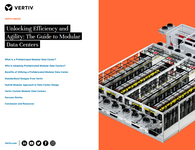Vertiv has introduced a prefabricated wooden data center module.
The TimberMod variant of its SmartMod container series uses mass timber instead of steel for structural elements, including the casing. It was launched at a press conference last week, and is available in the US and EMEA.
Vertiv says the wooden box will have a lower carbon footprint than the equivalent steel versions of the product, because timber causes less resource depletion and has a carbon footprint up to three times lower than steel.
Wood has been cited as a potential structural material for data centers for some time.
The pioneering EcoDataCenter in Sweden is built with cross-laminated "glulam" (glue-laminated) structural timber. Alongside this, the influential Boden Type data center, also in Sweden, uses timber in its construction as well.
In those cases, the wood is used to replace concrete, which has a very high carbon footprint. Other facilities use it more for decorative reasons, such as Ashton Old Baths in Manchester.
"Mass timber, if sourced from sustainably harvested wood, serves as a renewable construction material with the potential to minimize resource depletion and lower carbon footprint by up to three times compared to steel based on the reduction of CO2 emissions associated with the cradle-to-gate product lifecycle and the transport of materials and structural elements to the assembly site," says the Vertiv announcement.
The TimberMod product meets structural requirements for buildings, and is strong enough to resist seismic activity, wind forces, and structural demands. Vertiv also promises it "adds an aesthetic dimension to data center architecture."
“By incorporating materials from renewable sources, Vertiv TimberMod not only provides a more eco-friendly option but does so without compromising on performance, thus creating a positive impact on both the environment and our customers' operational efficiency,” said Viktor Petik, vice president and EMEA leader for Vertiv’s Integrated Modular Solutions business.
Vlad Galabov, director for cloud and data center at technology research and advisory group at Omdia, said: “Although timber data centers are not new, they have become much more accessible now that a major prefabricated modular data center vendor offers data center building blocks or an entire data center built with timber, with the engineering assurance that it will remain reliable."
Some critics have suggested that wood is unsuitable because it is flammable, citing the role of wooden floors and ceilings in the disastrous fire that destroyed OVHcloud's SBG2 data center in 2001. However, proponents point out that glulam structural components survive fires better than many other materials.
“Timber burns, but the good thing is that we know how it burns,” said architect Rune Abrahamsen, who built the world’s tallest timber building, an 18-story block in Norway called Mjøstårnet. "A timber building will remain standing after a fire has gone out by itself. The charring of wood creates an insulating layer that protects the inner part of the timber.”




